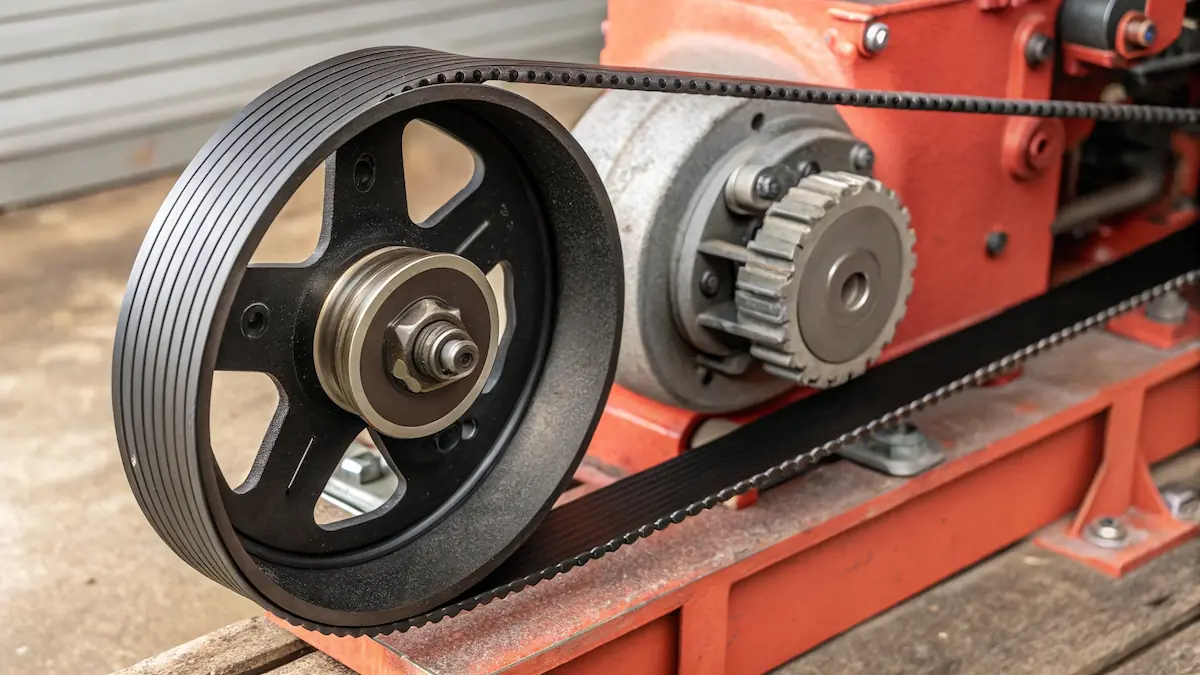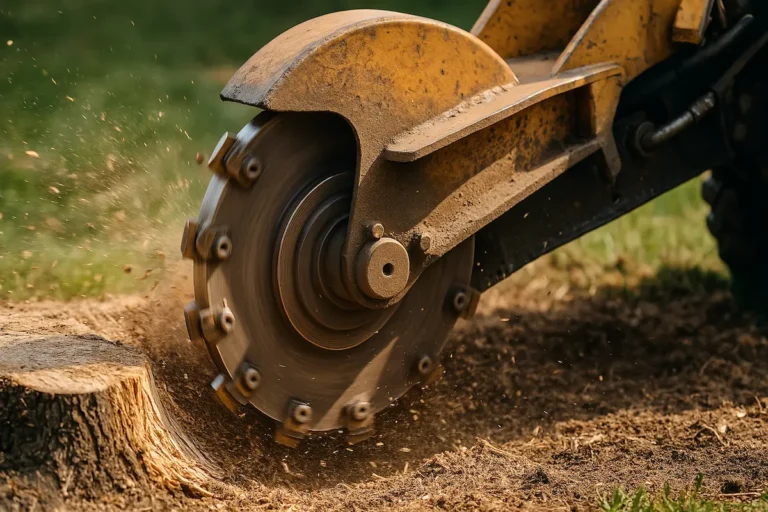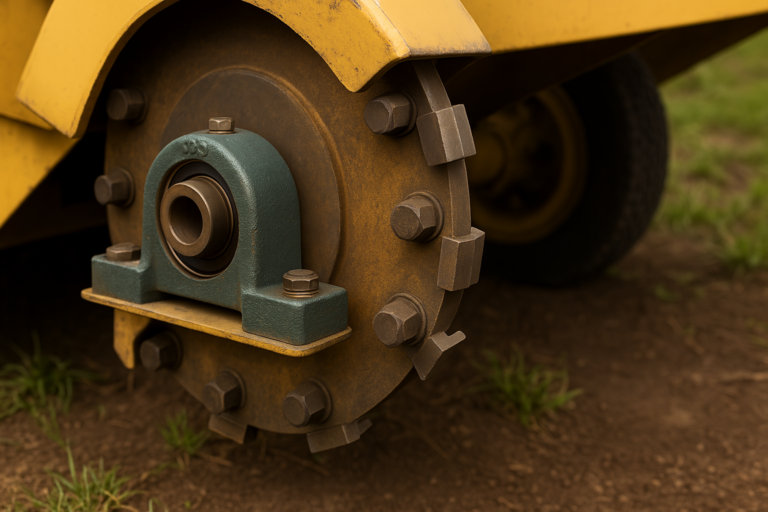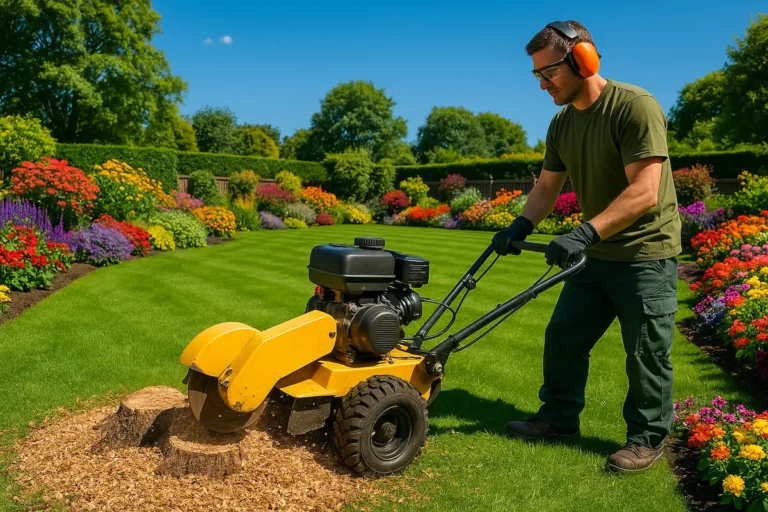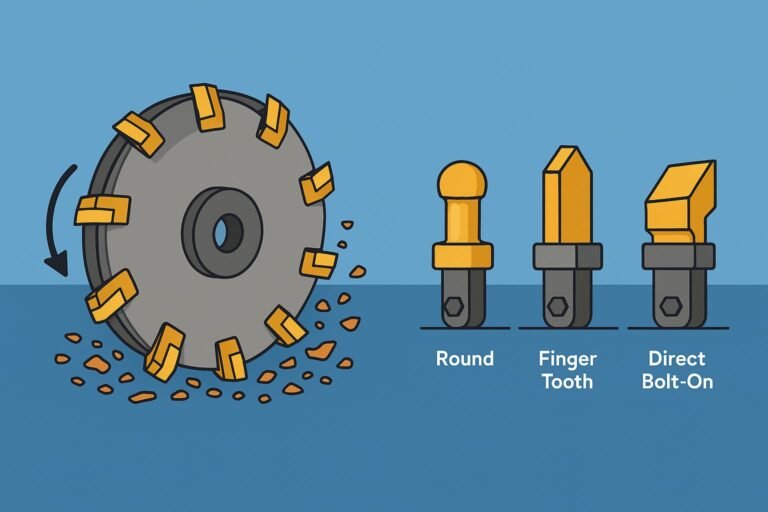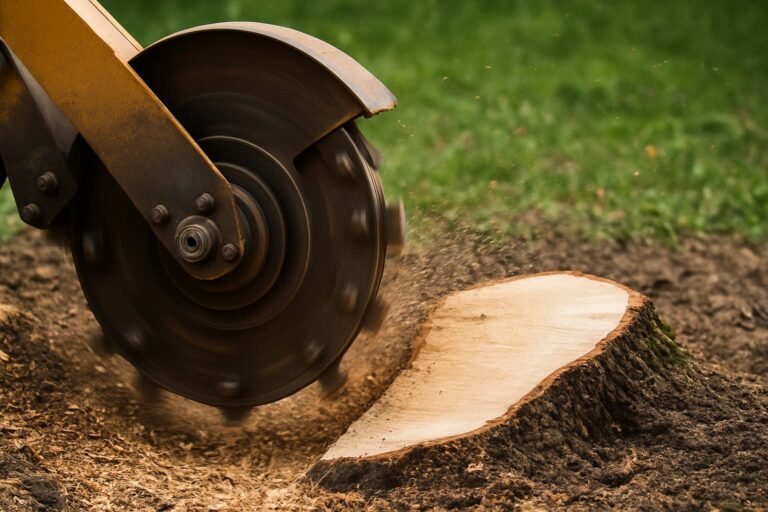The Hidden Hero of Your Tree Stump Grinder: V-Belts Explained
Are you wondering why your stump grinder feels weak? It might be the V-belt.
This guide provides an overview of V-belts.
You will learn what they do and how to spot problems. A healthy V-belt means a powerful grinder.
🔧 V-Belt Mastery for Stump Grinders
Your complete guide to identifying, preventing, and solving V-belt problems that could cost you time and money
📊 Problem Severity Analysis
🔥 Critical Issues
Burning smell/smoke: Stop immediately! Severe belt slipping can cause fire hazards and extensive damage.
⚠️ High Priority
Power loss/bogging: Significant performance impact requiring prompt attention to restore efficiency.
🔍 Monitor Closely
Squealing/visible wear: Early warning signs that need attention before becoming major problems.
🎯 Quick Problem Identification
Visible Cracks
Look for surface cracks, frayed edges, or glazed (shiny) appearance on the belt surface.
Tension Issues
Belt deflects too much when pressed, or feels overly tight with no give.
Contamination
Check for sap, oil, dirt, or debris that can cause slipping and premature wear.
📅 Maintenance Schedule
Daily Checks
Visual inspection for obvious damage, listen for unusual noises, check for debris buildup
Weekly Maintenance
Detailed tension verification, pulley alignment check, thorough cleaning routine
Monthly Service
Complete belt replacement assessment, professional inspection, performance evaluation
💰 True Cost of V-Belt Failure
Complete Failure
Emergency repairs, lost productivity, potential secondary damage
Performance Loss
Reduced efficiency, increased fuel consumption, delayed projects
Preventive Care
Regular maintenance, belt replacement, professional service
🔧 V-Belt Types for Stump Grinders
5V Series
Power: 25-100 HP
Use: Heavy Duty
Length: 50″-120″
8V Series
Power: 75-300 HP
Use: Industrial
Length: 80″-200″
Banded Belts
Power: High Load
Use: Multiple Belt
Benefits: Extra Strength
Cogged Belts
Power: Variable
Use: Flexible Apps
Benefits: Cooler Running
📈 Key Performance Statistics
⚠️ Safety First
Uncover the V-Belt’s Critical Role in Stump Grinding
V-belts are super important for your stump grinder. They are like the muscles of the machine. These special belts connect the engine to the big cutting wheel.
The engine makes power, and the V-belt moves that power. It spins the cutter wheel at a very high speed. This makes the grinder work properly.
Powering Your Grinder: Understand the V-Belt’s Function
V-belts ensure your grinder has plenty of power. The engine turns, and the belt takes that spin. It then sends it to the grinding wheel.
This is how the wheel gets its speed. Without a good belt, your grinder would not cut. It would just sit there.
| Belt Profile | Typical Use | Power Range | Common Lengths |
|---|---|---|---|
| 5V Series | Heavy Duty | 25-100 HP | 50″-120″ |
| 8V Series | Industrial | 75-300 HP | 80″-200″ |
Why a Healthy V-Belt Boosts Grinding Efficiency
A strong, healthy V-belt makes your job easy. It helps the grinder cut through tough stumps quickly. A good belt grips the pulleys tightly.
It moves all the engine’s power to the cutting teeth. This means your grinder works at its best. It will not slow down. It will chop through wood like butter.
Spot V-Belt Problems: Immediate Signs of Trouble
You can often tell when a V-belt has issues. Your grinder will give you clues. Please pay close attention to how it sounds and feels.
Look for these signs to catch problems early. Fixing them quickly saves you time and money.
Identify Power Loss and Bogging Down
One big sign is when your grinder loses power. It might bog down when you cut. This means the engine tries hard. But the cutting wheel does not spin fast enough.
It struggles to grind the stump. This often happens when the V-belt is slipping. It cannot send all the power. The engine works overtime.
Listen for Squealing or Chirping Noises
A loud squealing noise is a classic sign. It sounds like a high-pitched cry. This noise typically indicates that the belt is slipping. The belt loses its grip on the pulleys.
This creates friction and a loud sound. Chirping noises also tell you something is wrong. They can mean the belt is loose. Or it might be getting old.
Detect Burning Rubber Smell or Smoke
An intense burning smell is a severe warning. It smells like hot rubber. This means the belt is slipping very badly. The friction generates a significant amount of heat.
This heat can burn the rubber. You might even see smoke coming from the belt area. If you smell burning, stop the grinder right away. A burning belt is quickly wearing out. It could break completely soon.
Check for Visible Wear and Damage
Always look at your V-belts closely. You can see many problems. Inspect the belt surface for cracks. Look for frayed edges or loose threads.
A shiny, smooth area on the belt means it is glazed. This occurs when the belt slips frequently. It loses its grip. These are all signs of a damaged belt.
Common Problems Summary: Severity of V-Belt Issues
Understanding the severity of different V-belt problem signs helps prioritise immediate action.
Key Takeaways from V-Belt Problem Signs Chart:
- Burning Rubber Smell/Smoke: This is the most critical sign, indicating severe belt slipping and overheating. Stop the grinder immediately if you detect any issues to prevent damage and potential fire hazards.
- Power Loss/Bogging Down: A significant indicator of a slipping belt, directly impacting the grinder’s cutting performance and requiring prompt attention to restore full efficiency.
- Visible Wear and Damage: Signs like cracks, fraying, or a shiny, glazed surface on the belt signal that it’s nearing the end of its lifespan. While not always an immediate crisis, it indicates a strong need for replacement soon.
- Squealing or Chirping Noises: Often the earliest and most audible indicator of a loose or worn belt. While less severe than burning, it’s a clear warning that the belt requires adjustment or inspection to prevent further issues.
- Proactive Checks Save Time: Regularly inspecting your V-belt and addressing these signs early can prevent costly downtime more extensive machine damage, and ensure your grinder is always ready for peak performance.
Diagnose V-Belt Issues: A Quick Guide
Once you notice signs, it’s time to check the belt. You can do some simple checks yourself. This helps you confirm the problem. Safety is always the most important. Always turn off the grinder before you check.
Conduct a Thorough Visual Inspection
First, turn off the grinder. Disconnect the spark plug wire. This stops it from starting by accident. Now, look at the V-belt. Check its entire length.
Look for any cracks or tears. See if the belt seems shiny or glazed. This is a sign of old, slipping belts. Make sure no sap or dirt sticks to it.
Assess Correct Belt Tension
A V-belt needs the correct tension. Too loose, it slips. Too tight, it strains parts. Gently press on the belt. You should see a small amount of give.
It should deflect a little. Your grinder’s manual tells you how much. Proper tension makes the belt last longer. It also ensures the grinder operates efficiently.
Address V-Belt Problems: Practical Steps
If you find a problem, you need to fix it. Sometimes, a simple adjustment helps. At other times, you may need a new belt. Always follow safety rules.
Adjust V-Belt Tension Effectively
You can often fix a squealing belt by adjusting its tension. Look for the belt tensioner on your grinder. Your manual shows you how to find it. Loosen the bolts slightly.
Move the engine or an idler pulley. This tightens the belt. Then, tighten the bolts back up. Recheck the tension. Make sure it matches the manual. Proper tension is key.
Replace a Worn or Damaged V-Belt (Overview)
If your V-belt has cracks or looks bad, replace it. Trying to keep a bad belt can cause more damage. It can even be dangerous. Replacing a belt can be tricky.
You often need to remove guards. Then, you loosen the pulleys. You take the old belt off. Then you put the new one on. Always clean the pulleys. Could you make sure they are smooth? Then, set the tension for the new belt.
Important Note for Hire Customers: If you hire a grinder from us, please do not try to fix the belt yourself. Call us immediately. We will help you. We want to keep you safe. We want our grinders running perfectly.
Extend V-Belt Lifespan: Essential Maintenance
Good care makes V-belts last a long time. Simple checks can save you hassle. Think of it like taking care of your teeth. Small efforts prevent big problems.
Implement Regular Inspection Routines
Check your V-belts often. Do this before each big job. A quick look can catch problems early. Look for cracks, fraying, or shininess. Make sure the belt is clean. This simple check takes seconds. It can save hours of downtime.
Maintain Optimum Belt Tension
Always keep your belt tension just right. Check it often. Belts can stretch a little over time. They might lose tension. A loose belt slips. A tight belt wears out bearings. Refer to your grinder’s manual for the correct tension setting. This is one of the best ways to extend the life of your belt.
Keep Belts and Pulleys Clean
Dirt, sap, and sawdust can get on your V-belts. This makes them slip. It also makes them wear out faster. Always clean the belts and pulleys. Use a brush or rag. Ensure they are free from debris. This keeps them gripping well.
Store Grinders Properly
How you store your grinder matters. Could you keep it in a dry, cool place? Extreme heat or cold can harm V-belts. Moisture can also damage them. Proper storage helps the belts stay in good shape. It means they are ready for your next job.
Understand V-Belt Types and Sizing
Not all V-belts are the same. Stump grinders use specific types. Knowing a little about them helps you understand their importance.
Choose the Correct Belt Profile for Your Grinder
V-belts come in different shapes. These shapes are referred to as “profiles.” Some standard profiles are A, B, C, 3V, 5V, or 8V. Your grinder needs a specific profile.
Some belts have grooves on the inside. These are “cogged” belts. They bend easily. They run cooler. Other belts are joined together. These are “banded” belts. They handle considerable power better. Always use the belt type listed in your grinder’s manual.
Recognise Why the Right Fit Ensures Performance
The V-belt must be the right size. It needs the correct length and width. A belt that is too long will be loose. It will slip. A belt that is too short will be too tight.
This can damage the parts of your grinder. The right fit means the belt works perfectly. It gives you full power.
Calculate the True Cost of V-Belt Failure
A broken V-belt means more than just a new belt. It costs you time and money. It can mess up your entire day. Considering these costs helps you appreciate the value of a high-quality V-belt.
Avoid Costly Downtime and Lost Revenue
Imagine you are on a job. Your grinder suddenly stops. The V-belt broke. Now you cannot work. This is called downtime. For a rental customer, this means you lose precious time. You may need to pay for additional hire days. Or you might miss a deadline. This quickly adds up.
For example, a landscaping company once had a big job. They planned to finish it in one day. Their rented grinder suddenly lost power. It was a slipping V-belt.
They spent an hour on the phone. They then waited two hours for the repair. The job finished late. They lost half a day’s pay. That half-day could have earned them hundreds of pounds. The cost of a new belt is small. The cost of lost work is much higher.
Prevent Unexpected Repair Expenses
Sometimes, a faulty V-belt can cause additional damage. A broken belt can hit other parts. A slipping belt makes the engine work harder. This uses more fuel. It can also harm engine parts over time. Fixing these things costs much more than just a belt. Proactive care stops these enormous bills.
Safeguard Your Job Quality and Customer Satisfaction
When your grinder operates efficiently, your customers are satisfied. You finish on time. You do a good job. A grinder with a bad belt might struggle. It leaves a messy stump.
Or it takes too long. This makes your customers unhappy. It can hurt your reputation. People want reliable service. We know this at treestumpgrinderhire.com. We make sure our grinders are always ready.
Quote: “My hired grinder felt weak on big stumps. I called the rental place. They said it was probably the belt. They came out, changed it, and it was a beast again!” – A happy customer.
Experience the treestumpgrinderhire.com Difference.
At treestumpgrinderhire.com, we understand V-belts. We know how important they are.
Handle V-Belt Issues During Your Hire
Even with our checks, issues can pop up. If you rent a grinder from us and experience a V-belt issue, please get in touch with us. Stop using the grinder.
We will give you clear instructions. We will guide you on the following steps to take. We are here to help.
Benefit from Our Pre-Hire Checks and Spotting Guide
Before you take our grinder, we thoroughly inspect it to ensure it is in good working condition. This includes the V-belt. We can even show you what we look for. It takes just a minute. You can quickly check it yourself. We want you to feel confident. We want you to have a great grinding experience.
Answer Your V-Belt Questions: Frequently Asked
Here are some common questions people ask about V-belts. We hope these answers help you.
How Do I Know if My V-Belt is Slipping?
You will notice a few things. The grinder loses power. It bogs down more often. You might hear a squealing noise. A burning rubber smell is a strong sign. The belt itself might look shiny or glazed. These all point to a slipping belt.
What Causes a V-Belt to Break on a Stump Grinder?
Many things can cause a V-belt to break. If the tension is incorrect, it can cause harm. Too loose, it slips and burns. Too tight, it strains itself. Old age makes belts weaker. They wear out over time. Dirt or oil on the belt makes it slip. Sudden strong forces on the grinder can also snap a belt. Using the wrong belt type also causes breaks.
How Often Should I Replace a V-Belt on a Stump Grinder?
This depends on how much you use it. It also depends on the grinder model. Some belts last longer than others. Generally, they last from 100 to 500 hours of use. You should always replace them when you see cracks. Replace them if they are frayed or glazed. Always refer to your grinder’s manual for specific instructions. Our team replaces belts on our hire fleet as needed. We do this much more often than 500 hours. We do it based on conditions.
What Type of V-Belt Do Stump Grinders Use?
Stump grinders use strong V-belts. They need to handle a lot of power. They often use specific profiles, such as 5V or 8V. These are narrow but strong belts. Some are “banded.” This means several belts are joined together. This gives them extra strength. Always use the exact belt type and size recommended by your grinder’s manufacturer.
Can I Adjust the V-Belt Tension on My Own?
For equipment you own, you can often adjust tension. You follow the steps in your manual. For a hired grinder, please refrain from attempting this yourself. Contact us immediately. We will help. We want to ensure your safety. We also want to keep our equipment in perfect working order. This protects you and future renters.
Power Your Grinding Success: A Concluding Thought
V-belts are small parts. But they make a huge difference. They are vital for your stump grinding job. A healthy V-belt means a powerful, safe, and efficient grinder. Now you know how to spot problems. You also understand the importance of maintenance.
Choose treestumpgrinderhire.com for your next stump grinding job. We pride ourselves on reliable machines. We ensure that our V-belts are always in top condition. This means you get a grinder that works. It works when you need it.

